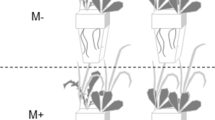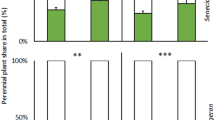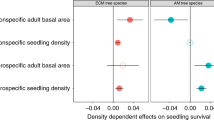Abstract
ECOLOGICAL study of the role of soil microorganisms in vegetation succession has focused mainly on organisms affecting plant nutrition, such as mycorrhiza and nitrogen-fixing bacteria. But, soil-borne diseases are involved in the degeneration of Ammophila arenaria (Marram grass) and Hippophaë rhamnoides (Sea buckthorn), two plant species that dominate the coastal foredunes of Europe and are widely planted for sand stabilization. We have used reciprocal transplantation and report here that soil-borne diseases may contribute to the succession of foredune plant species. In pot experiments, plant species that succeed A. arenaria were tolerant of the soil-borne diseases of this species. Plant species that were grown in soils from both previous and later succession stages were reduced most in soils from the later stages. During foredune succession, therefore, plants disappear from sites where the soil has become colonized with specific growth-depressing microorganisms. The soil-borne diseases must have considerable importance for the outcome of interspecific competition and may be involved in patterns of clonal growth. The different sensitivities of plant species for the soil-borne pathogens could be an evolutionary response to selection pressures of the succession stage to which a species is confined by the combined effect of local abiotic and biotic environmental factors.
This is a preview of subscription content, access via your institution
Access options
Subscribe to this journal
Receive 51 print issues and online access
$199.00 per year
only $3.90 per issue
Buy this article
- Purchase on Springer Link
- Instant access to full article PDF
Prices may be subject to local taxes which are calculated during checkout
Similar content being viewed by others
References
Laing, C. C. Am. Midl. Nat. 77, 495–500 (1967).
Eldred, R. A. & Maun, M. A. Can. J. Bot. 60, 1371–1380 (1982).
Tietema, T. thesis, Univ. Utrecht, The Netherlands (1981).
Noble, J. C. J. Ecol. 70, 867–886 (1982).
Willis, A. J. Proc. R. Soc. Edinb. 96B, 17–36 (1989).
Marshall, J. K. J. Ecol. 53, 447–463 (1965).
Wallén, B. Oikos 34, 227–238 (1980).
Salisbury, E. Downs and Dunes: Their Plant Life and its Environment (Bell, London. 1952).
Ranwell, D. S. J. Ecol. 46, 83–100 (1958).
Huiskes, A. H. L. J. Ecol. 67, 363–382 (1979).
Baye, P. R. thesis, Univ. Western Ontario, London, Canada (1990).
Anderson, C. & Taylor, K. in Ecological Processes in Coastal Environments (eds Jefferies, R. L. & Davy, A. J.) 129–143 (Blackwell, Oxford, 1979).
Willis, A. J. J. Ecol. 53, 735–745 (1965).
Hope-Simpson, J. F. & Jefferies, R. L. J. Ecol. 54, 271–275 (1966).
Oremus, P. A. I. & Otten, H. Pl. Soil 63, 317–331 (1981).
Maas, P. W. Th., Oremus, P. A. I. & Otten, H. Pl. Soil 73, 141–147 (1983).
Zoon, F. C. Rev. Nématol. 9, 314 (1986).
Zoon, F. C. in Proc. 1st Conf. Eur. Found Pl. Path. (eds Beemster, A. B. R. et al.) 47–53 (Elsevier, Amsterdam, 1991).
Moore, P. D. Nature 296, 805–806 (1982).
Van der Putten, W. H., Van Dijk, C. & Troelstra, S. R. Oecologia 76, 313–320 (1988).
Van der Putten, W. H., Maas, P. W. Th., Van Gulik, W. J. M. & Brinkman, H. Soil Biol. Biochem. 22, 845–852 (1990).
Van der Goes, P. C. E. M. & Van der Putten, W. H. Meded. Rijksfac. Landbouww. Rijksuniv. Gent 57/3a, 847–856 (1992).
Van der Putten, W. H., Van der Werf-Klein Breteler, J. T. & Van Dijk, C. Pl. Soil 120, 213–223 (1989).
Van der Putten, W. H. & Troelstra, S. R. Can J. Bot. 68, 1560–1568 (1990).
De Nooy, M. P., Troelstra, S. R. & Wagenaar, R. Oecologia 70, 266–272 (1986).
Nicolson, T. H. & Johnston, C. Trans. Brit. mycol. Soc. 72, 261–268 (1979).
Hassouna, M. G. & Wareing, P. F. Nature 202, 467–469 (1964).
Gray, A. J., Crawley, M. J. & Edwards, P. J. Colonization, Succession and Stability (British Ecological Society Symposium, Blackwell Scientific, Oxford, 1987).
Carey, P. D., Fitter, A. H. & Watkinson, A. R. Oecologia 90, 550–555 (1992).
Novozamsky, I., Houba, V. J. G., Temminghoff, E. & Van der Lee, J. J. Neth. J. Agric. Sci. 32, 322–324 (1984).
Hewitt, E. J. Sand and Water Culture Methods Used in the Study of Plant Nutrition (CAB Bureaux, Farnham Royal, 1966).
Author information
Authors and Affiliations
Rights and permissions
About this article
Cite this article
Van der Putten, W., Van Dijk, C. & Peters, B. Plant-specific soil-borne diseases contribute to succession in foredune vegetation. Nature 362, 53–56 (1993). https://doi.org/10.1038/362053a0
Received:
Accepted:
Published:
Issue Date:
DOI: https://doi.org/10.1038/362053a0
This article is cited by
-
Plant–soil feedback effects on conspecific and heterospecific successors of annual and perennial Central European grassland plants are correlated
Nature Plants (2023)
-
Extant species are more responsive than locally extinct species to warming effects on soil communities
Plant and Soil (2023)
-
Plant-soil feedback: incorporating untested influential drivers and reconciling terminology
Plant and Soil (2023)
-
Effects of sand burial depth on Xanthium spinosum seed germination and seedling growth
BMC Plant Biology (2022)
-
Changes in precipitation patterns can destabilize plant species coexistence via changes in plant–soil feedback
Nature Ecology & Evolution (2022)
Comments
By submitting a comment you agree to abide by our Terms and Community Guidelines. If you find something abusive or that does not comply with our terms or guidelines please flag it as inappropriate.



